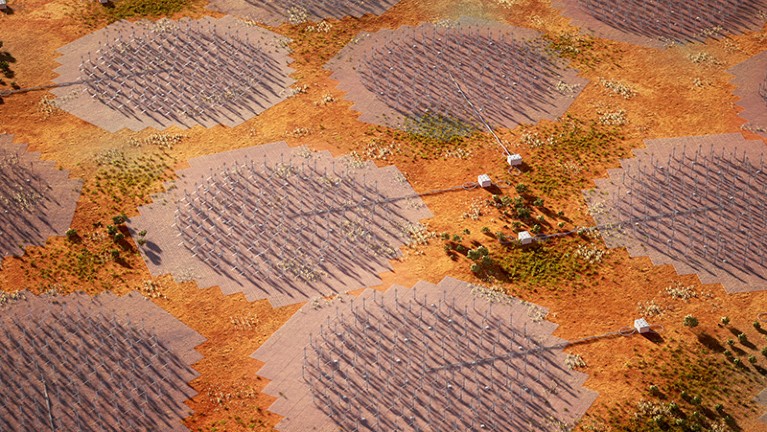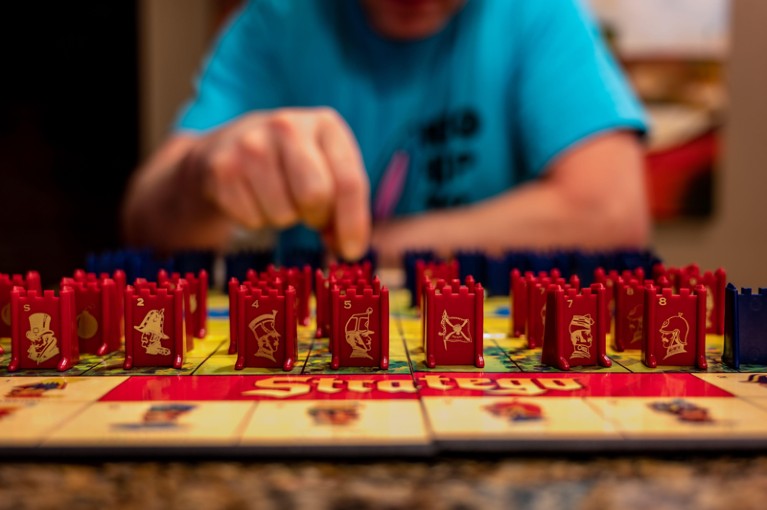
An artists’ impression of SKA-Low antenna arrays.Credit: DISR
Construction of gigantic radio observatory begins
After 30 years of planning and negotiations, construction began last week on the Square Kilometre Array (SKA), the world’s largest radio-astronomy observatory. The giant instrument — to be built as two telescopes across sprawling sites in Australia and Africa — will collect radio signals emitted by celestial objects and will hopefully shed light on the nature of dark matter and how galaxies form.
The SKA will be built in stages, and the €1.3-billion (US$1.4-billion) first phase is expected to be completed in 2028. The SKA-Low telescope, in Australia, will comprise about 131,000 antennas, each resembling a 2-metre-tall wire Christmas tree. More than 500 arrays of 256 antennas will dot the red sands of the site (artist’s impression pictured). The large distances between antennas and their sheer number mean that the telescopes will pick up radio signals with unprecedented sensitivity.
Preparations have also begun for building the first giant SKA-Mid dishes. There will be 197 of these antennas, extending over about 150 kilometres in South Africa’s dry Karoo region.
The final goal is to have thousands of dishes in Africa, and one million antennas in Australia, with a collecting area of one square kilometre.

DeepNash has mastered an online version of the board game Stratego.Credit: Lost in the Midwest/Alamy
AI systems topple experts at complex games Stratego and Diplomacy
Two games that have been long considered extremely difficult for artificial intelligence to master have fallen to machines. An artificial intelligence (AI) system called DeepNash, made by London-based company DeepMind, has used a combination of reinforcement learning and a deep neural network to master Stratego, a game that requires strategic thinking in the face of imperfect information (J. Perolat et al. Science 378, 990–996; 2022).
Meanwhile, a team at Meta AI, headquartered in New York City, has built Cicero, an AI that can negotiate and cooperate in the multi-player game Diplomacy (A. Bakhtin et al. Science 378, 1067–1074; 2022).
“The rate at which qualitatively different game features have been conquered — or mastered to new levels — by AI in recent years is quite remarkable,” says Michael Wellman at the University of Michigan in Ann Arbor, a computer scientist who studies strategic reasoning and game theory. “Stratego and Diplomacy are quite different from each other, and also possess challenging features notably different from games for which analogous milestones have been reached.”
For two weeks in April, DeepNash competed with human Stratego players on online game platform Gravon. After 50 matches, it was ranked third among all Gravon Stratego players since 2002.
The team behind Cicero reported that in 40 online games of Diplomacy, the AI achieved more than double the average score of the human players and was ranked in the top 10% of participants who played more than one game.
The achievements could pave the way for real-world applications, such as improving the technology underlying self-driving cars. But more work is needed. “Many of these techniques are indeed relevant beyond recreational games,” Wellman says. “Nevertheless, at some point, the leading AI research labs need to get beyond recreational settings, and figure out how to measure scientific progress on the squishier real-world ‘games’ that we actually care about.”

